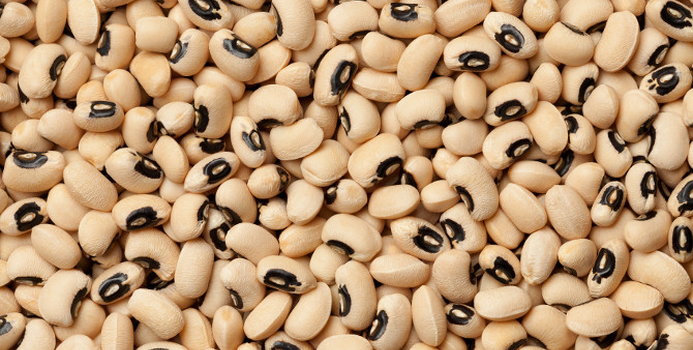Black-eyed peas get their names from their characteristic appearance. They are white legumes with a small black dot resembling an eye. These delicious beans are well known in Southern and Southwestern cooking, but the nutrition of the black-eyed pea makes it an excellent addition to any menu.
Black-Eyed Peas and the Food Guide Pyramid
Although the black-eyed pea is a plant food, on the Food Guide Pyramid, created by the United States Department of Agriculture, the bean is included in the "Meat and Beans" section because it can be used as a protein source instead of an animal food. In fact, many vegetarians use legumes to substitute for meat when planning meals. One serving of black-eyed peas is equal to one-half cup.
Calories
One serving of black-eyed peas contains 70 calories, making it a low-calorie option when served without additional condiments. The majority of calories comes from carbohydrate sources (16 grams). Each serving also contains three grams of protein. The beans do not contain any fat or cholesterol.
Fiber
As with all legumes, black-eyed peas are very good fiber sources, providing 4 grams or 16% of the recommended daily value. There are two types of dietary fiber: soluble and insoluble. Beans contain mostly soluble fiber, which can help decrease blood cholesterol levels and therefore may help reduce the risk of heart disease. Soluble fiber may also help patients with diabetes maintain improved blood sugar levels because the fiber helps to slow the rate of absorption of carbohydrate.
Vitamins and Minerals
Black-eyed peas are especially rich sources of potassium. This mineral is important for the proper function of all cells, tissues and organs in the body. It is also crucial for heart function and plays a key role in muscle contraction. Healthy adults over the age of 19 need at least 2000 milligrams per day, and black-eyed peas provide over half that in one serving (1148 milligrams).
Black-eyed peas do contain a small amount of naturally occurring sodium: 48 milligrams. However, because of their other heart-healthy nutrients, legumes are encouraged for even those with cardiovascular disease or high blood pressure.
Zinc is another mineral found in black-eyed peas. Zinc is involved in many aspects of cellular metabolism, and is therefore essential for the immune function, protein synthesis, wound healing and healthy cell division. Black-eyed peas provide five of the 8-11 milligrams of zinc that is recommended each day by the Food and Nutrition Board of the Institutes of Medicine.
Most beans, including black-eyed peas, are a rich source of iron. Iron is an essential component of one of the proteins found in the red blood cells which carry oxygen to all body tissues. Black-eyed peas contain 6% of the daily value of iron in the form of non-heme iron. The peas also contain 1.3 milligrams of vitamin C which helps the body absorb non-heme iron.



